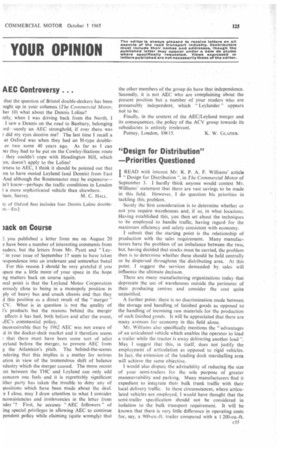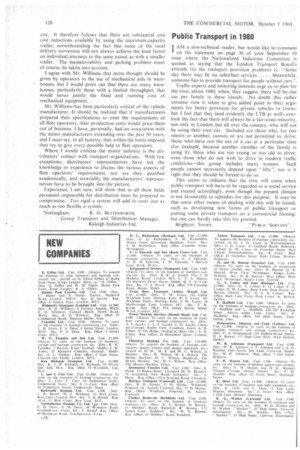YOUR OPINION
Page 127

Page 128

If you've noticed an error in this article please click here to report it so we can fix it.
The editor is always pleased to receive letters on all aspects of the road transport industry. Contributors must Include their names and addresses, though the published letter may appear under a nom de plume where specifically requested. Views expressed in letters published are not necessarily those of the editor.
AEC Controversy
that the question of Bristol double-deckers has been )ught up in your columns (The Commercial Motor, ber 10) what about the Dennis Lofine?
ntly, when I was driving back from the North, I I saw a Dennis on the road to Banbury, belonging )rd—surely an AEC stronghold, if ever there was r did my eyes deceive me? The last time I recall a at Oxford was when they had an H-type doubleor two some 40 years ago. As far as I can )er they had to be put on the Cowley-Stations route : they couldn't cope with Headington Hill, which ire, doesn't apply to the Loline!
irness to AEC, I think it should be pointed out that .trn to have ousted Leyland (and Dennis) from East And although the Routemaster may be expensiveln't know—perhaps the traffic conditions in London 1 a more sophisticated vehicle than elsewhere.
ham, Surrey. M. C. HALL.
ty of Oxford fleet includes four Dennis Lane doublers.---Eo.j
mck on Course
you published a letter from me on August 20 e have been a number of interesting comments from eaders, but the letters from Mr. Pyatt and " Ley' in your issue of September 17 seem to have taken respondence into an irrelevant and somewhat banal For this reason I should be very grateful if you spare me a little more of your space in the hope ng matters back on course again.
real point is that the Leyland Motor Corporation erously close to being in a monopoly position in ply of heavy bus and coach chassis and that they d this position as a direct result of the " merger " CV. What is in question is not the quality of l's products but the reasons behind the merger affects it has had, both before and after the event, EEC's commercial policy.
inconceivable that by 1962 AEC was not aware of d in the docker-deck market and it therefore seems that there must have been some sort of edict eyland before the merger, to prevent AEC from g the AtIantean's pitch. The behind-the-scenes ndering that this implies is a matter for serious ation in view of the tremendous shift of balance ridustry which the merger caused. The more recent :nt between the THC and Leyland can only add concern one feels and it is regrettably significant ither party has taken the trouble to deny any of positions which have been made about the deal. .e I close, may I draw attention to what I consider nconsistencies and irrelevancies in the letter from ider "? First, he accuses "AEC followers" of Ling special privileges in allowing AEC to continue pendent policy while claiming (quite wrongly) that the other members of the group do have that independence. Secondly, it is not AEC who are complaining about the present position but a number of your readers who are presumably independent, which " Leylander " appears not to be.
Finally, in the context of the AEC/Leyland merger and its consequences, the policy of the ACV group towards its subsidiaries is entirely irrelevant.
Putney, London, SWI5. K. W. GLAZIER.
"Design for Distribution" —Priorities Questioned
READ with interest Mr. R. P. A. F. Williams' article
1 "Design for Distribution ", in The Commercial Motor of September 3. I hardly think anyone would contest Mr. Williams' statement that there are vast savings to be made in this field. However, I do question his priorities in tackling this problem.
Surely the first consideration is to determine whether or not you require warehouses and, if so, in what locations. Having established this, you then set about the techniques to be employed to handle traffic, having regard for the maximum efficiency and safety consistent with economy.
I submit that the starting point is the relationship of production with the sales requirement. Many manufacturers have the problem of an imbalance between the two, but, having decided that stocks must be carried, the problem then is to determine whether these should be held centrally or be dispersed throughout the distributing area. At this point, I suggest the services demanded by sales will influence the ultimate decision.
There are many manufacturing organizations today that deprecate the use of warehouses outside the perimeter of their producing centres and consider the cost quite unjustified.
A further point: there is no discrimination made between the storage and handling of finished goods as opposed to the handling of incoming raw materials for the production of such finished goods. It will be appreciated that there are many avenues for economy in this field alone.
Mr. Williams also specifically mentions the "advantages of an articulated vehicle which enables the operator to load a trailer while the tractor is away delivering another load ". May I suggest that this, in itself, does not justify the employment of articulation as opposed to rigid vehicles. In fact, the extension of the loading dock marshalling area will achieve the same objective.
I would also dispute the advisability of reducing the size of your semi-trailers for the sole purpose of greater manoeuvrability and parking. Many manufacturers find it expedient to integrate their bulk trunk traffic with their local delivery traffic. In these circumstances, where articulated vehicles are employed, I would have thought that the semi-trailer specification should not be considered in isolation to the bulk transport requirement. It will be known that there is very little difference in operating costs for, say, a 900-cu.-ft. trailer compared with a I 200-cu.-ft.
one. It therefore follows that there are substantial unit cost reductions available by using the maximum-capacity trailer, notwithstanding the fact that some of the local delivery movement will not always achieve the load factor on individual journeys to the same extent as with a smaller trailer. The manceuvrability and parking problem must, of course, be taken into account, I agree with Mr. Williams that more thought should be given by operators to the use of mechanical aids in ware . houses, but I would point out that there are many warehouses, particularly those with a limited throughput, that would never justify the fixed and running cost of mechanical equipment.
Mr. Williams has been particularly critical of the vehicle manufacturer. It should be realized that if manufacturers prepared their specifications to meet the requirements of all 'fleet operators, their production costs would price them out of business. I have, personally, had an association with the motor manufacturers extending over the past 30 years, and I must say, in all honesty, that within the limits imposed they try to give every possible help to fleet operators.
Where I would criticize the motor industry is the distributors' contact with transport organizations. With few exceptions, distributors' representatives have not the knowledge or experience to discuss the various aspects of fleet operators' requirements, -nor are they qualified academically, and invariably the manufacturers' representatives have to be brought into the picture.
Experience, I am sure, will show that in all these fields personnel responsible for distribution must be prepared to compromise. Too rigid a system will add to costs just as much as too flexible a system.
Nottingham. R. G. BE rTESWORTH.
Group Transport and Distribution Manager, Raleigh Industries Ltd.
Public Transport in 1980
I AM a non-technical reader, but would like to comment 1 on the statement on page 36 of your September 10 issue where the Nationalized Industries Committee is quoted as saying that the London Transport Board's attitude (to the transport provision problem) is: "Some day there may be no suburban services . . . . Meanwhile, someone has to provide transport for people without cars Traffic experts and motoring interests urge us to plan for the time, about 1980, when, they suggest, there will be one car per family in these islands. No doubt this rather extreme view is taken to give added point to their arguments for better provision for private vehicles in towns: but I feel that they (and evidently the LTB as well) overlook the fact that there will always be a fair-sized minority, not only in London but all over the country, who will not be using their own car. Included are those who, for one reason or another, cannot, or are not permitted to, drive: those who have not the use of a car at a particular time (for example, because another member of the family is using it): those who are too young or too old to drive: even those who do not wish to drive in modern traffic conditions—this group includes many women. Such people cannot necessarily depend upon " lifts ", nor is it right that they should be forced-to do so.
This seems to indicate that the time will come when public transport will have to be regarded as a social service and treated accordingly, even though the present climate is not favourable to subsidies for this purpose. It may be that some other means of dealing with this will be found, such as developing new forms of public transport or putting some private transport on a commercial footing: but one can hardly take this for granted.
Brighton. Sussex. " PUBLIC SERVANT-.












































































































































































